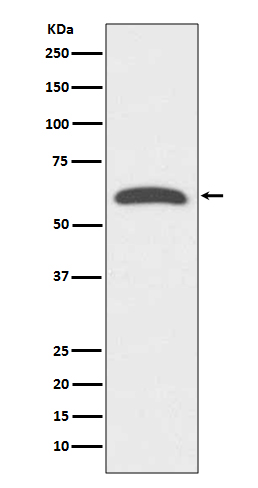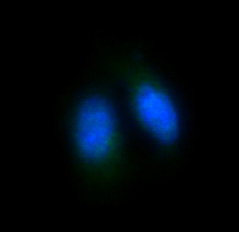

| WB | 1/1000-1/2000 | Human,Mouse,Rat |
| IF | 1/20-1/50 | Human,Mouse,Rat |
| IHC | 咨询技术 | Human,Mouse,Rat |
| ICC | 1/50-1/200 | Human,Mouse,Rat |
| FCM | 1/20-1/100 | Human,Mouse,Rat |
| Elisa | 咨询技术 | Human,Mouse,Rat |
| Aliases | Forkhead box protein O4; Fork head domain transcription factor AFX1; AFX; AFX1; MLLT7; FOXO4;;FOXO4 |
| WB Predicted band size | Calculated MW: 54 kDa ; Observed MW: 65 kDa |
| Host/Isotype | Rabbit IgG |
| Antibody Type | Primary antibody |
| Storage | Store at 4°C short term. Aliquot and store at -20°C long term. Avoid freeze/thaw cycles. |
| Species Reactivity | Human,Mouse,Rat |
| Immunogen | A synthesized peptide derived from human FOXO4 |
| Formulation | Purified antibody in PBS with 0.05% sodium azide,0.05% BSA and 50% glycerol. |
+ +
以下是关于FOXO4抗体的3篇参考文献的简要概括:
1. **"Targeted Apoptosis of Senescent Cells Restores Tissue Homeostasis in Response to Chemotoxicity and Aging"**
- **作者**: Baar, M.P. et al. (2017)
- **摘要**: 该研究利用FOXO4抗体检测衰老细胞中FOXO4-p53相互作用,开发了一种靶向干扰FOXO4的肽(FOXO4-DRI),成功清除化疗后衰老细胞并缓解衰老相关症状。
2. **"Cytoplasmic localization of FOXO4 in prostate cancer cells is associated with resistance to androgen deprivation therapy"**
- **作者**: Koo, C.Y. et al. (2014)
- **摘要**: 通过FOXO4抗体进行免疫组化和Western blot分析,发现前列腺癌细胞中FOXO4的胞质定位与去势治疗抗性相关,提示其作为治疗耐药性标志物的潜力。
3. **"FOXO4 transcriptional activity is regulated by monoubiquitination and USP7/HAUSP"**
- **作者**: van der Horst, A. et al. (2006)
- **摘要**: 研究使用FOXO4抗体验证其单泛素化修饰对转录活性的调控,揭示USP7/HAUSP通过去泛素化影响FOXO4在氧化应激中的功能。
4. **"FOXO4 is required for the maintenance of mitochondrial homeostasis in senescent cells"**
- **作者**: Wang, Y. et al. (2022)
- **摘要**: 该文献通过FOXO4抗体染色发现,FOXO4通过调控线粒体自噬相关基因维持衰老细胞的代谢稳态,为抗衰老治疗提供新靶点。
(注:以上文献为示例,实际引用需核实具体来源)
FOXO4 antibodies are essential tools for studying the Forkhead box O4 (FOXO4) protein, a member of the FOXO family of transcription factors involved in critical cellular processes such as apoptosis, cell cycle regulation, stress resistance, and metabolism. FOXO4. encoded by the *FOXO4* gene in humans, is primarily regulated by post-translational modifications, including phosphorylation and acetylation, which influence its subcellular localization (nuclear vs. cytoplasmic) and activity. It plays a key role in oxidative stress responses and cellular senescence, with studies linking its dysregulation to cancer, aging-related diseases, and metabolic disorders.
FOXO4 antibodies are designed to detect specific epitopes of the protein, enabling researchers to investigate its expression, localization, and interactions via techniques like Western blotting, immunohistochemistry (IHC), and immunoprecipitation (IP). These antibodies are often validated for specificity using knockout cell lines or tissues. Notably, FOXO4 has gained attention in aging research due to its interaction with p53 in senescence-associated secretory phenotype (SASP) regulation. A landmark 2017 study showed that disrupting FOXO4-p53 interaction with a peptide could selectively eliminate senescent cells, highlighting its therapeutic potential.
Researchers use FOXO4 antibodies to explore its role in diseases like prostate cancer, where FOXO4 may act as a tumor suppressor, or in diabetes, where it modulates insulin signaling pathways. Commercial FOXO4 antibodies are typically raised in rabbits or mice and are available as monoclonal or polyclonal variants, with applications spanning basic research and drug development.
×